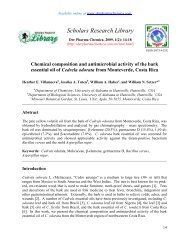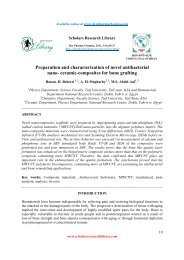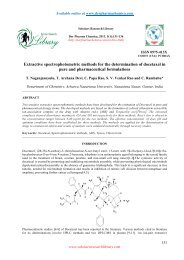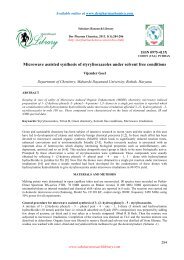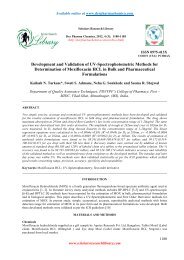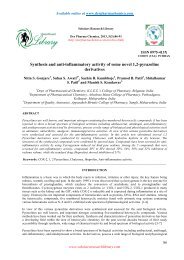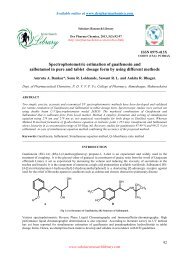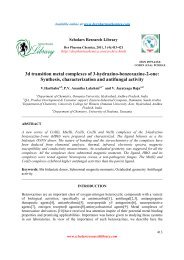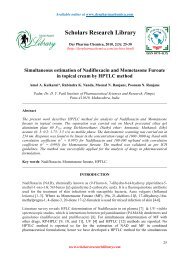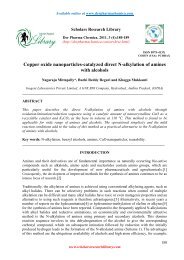Synthesis and evaluation of some novel thiomers as mucoadhesive ...
Synthesis and evaluation of some novel thiomers as mucoadhesive ...
Synthesis and evaluation of some novel thiomers as mucoadhesive ...
Create successful ePaper yourself
Turn your PDF publications into a flip-book with our unique Google optimized e-Paper software.
Available online at www.derpharmachemica.com<br />
Scholars Research Library<br />
Der Pharma Chemica, 2012, 4(4):1385-1396<br />
(http://derpharmachemica.com/archive.html)<br />
ISSN 0975-413X<br />
CODEN (USA): PCHHAX<br />
<strong>Synthesis</strong> <strong>and</strong> <strong>evaluation</strong> <strong>of</strong> <strong>some</strong> <strong>novel</strong> <strong>thiomers</strong> <strong>as</strong> <strong>mucoadhesive</strong> polymer<br />
Sudhir S. L<strong>and</strong>ge 1 , Rajesh J. Oswal* 2 , Atul S. Sayare 1 , Rishikesh V. Antre 2 , S<strong>and</strong>ip Y. Patil 1<br />
1 Department <strong>of</strong> Pharmaceutical Chemistry, C.A.Y.M.A.T.'s Siddhant College <strong>of</strong> Pharmacy, Sudambare,<br />
Maval, Pune, Pin-412 109<br />
2 Department <strong>of</strong> Pharmaceutical Chemistry, JSPM`s Charak College <strong>of</strong> Pharmacy & Research, Wagholi,<br />
Pune-412 207<br />
_____________________________________________________________________________________________<br />
ABSTRACT<br />
The purpose <strong>of</strong> the present study w<strong>as</strong> to synthesize <strong>and</strong> characterize <strong>novel</strong> thiolated polymers mediated by<br />
carbodiimide. Cysteine w<strong>as</strong> covalently linked to sodium carboxymethyl starch (CMS) <strong>and</strong> carboxymethyl guar gum<br />
(CMG). Depending on the weight-ratio polymer to cysteine during the coupling reaction, the resulting CMG-<br />
Cysteine conjugates displayed 80% ± 2.6 thiol groups per gm <strong>of</strong> polymer were <strong>as</strong> CMS-Cysteine conjugates<br />
displayed 78% ± 2.1. (mean ± S.D.; n=3).In aqueous solution above pH 6.0 polymers were capable <strong>of</strong> forming inter<strong>and</strong>/or<br />
intra-molecular disulfide bonds. Mucoadhesion studies carried out on freshly excised sheep intestinal<br />
mucosa. The CMS-Cysteine displayed less mucoadhesion where <strong>as</strong> CMG-Cysteine conjugate were displayed<br />
incre<strong>as</strong>ed mucoadhesion. The swelling behaviour <strong>of</strong> the CMS-Cysteine conjugate w<strong>as</strong> influenced by the covalent<br />
attachment <strong>of</strong> the sulfhydryl compound. In contr<strong>as</strong>t the swelling behaviour <strong>of</strong> CMG-Cysteine w<strong>as</strong> not influenced by<br />
the immobilisation <strong>of</strong> cysteine. Furthermore, in aqueous solutions the cumulative % drug rele<strong>as</strong>e time <strong>of</strong> tablet<br />
b<strong>as</strong>ed on the CMG-Cysteine w<strong>as</strong> prolonged 1.5 fold <strong>as</strong> compared to tablet containing CMS-Cysteine conjugate. Due<br />
to a high crosslinking tendency by the formation <strong>of</strong> disulfide bonds stabilizing drug carrier systems b<strong>as</strong>ed on<br />
thiolated polymers <strong>and</strong> permeation enhancing effect, CMG-Cysteine conjugates represent promising excipients for<br />
the development <strong>of</strong> <strong>novel</strong> drug delivery system.<br />
Keywords: CMS-Cysteine conjugates; Mucoadhesion; Permeation enhancement; CMG-Cysteine conjugates;<br />
Thiomers.<br />
_____________________________________________________________________________________________<br />
INTRODUCTION<br />
The concept <strong>of</strong> mucoadhesion h<strong>as</strong> been pioneered in the 1980s; numerous attempts have been taken in order to<br />
improve the adhesive properties <strong>of</strong> polymers. These attempts include approaches such <strong>as</strong> the use <strong>of</strong> linear poly<br />
(ethylene glycol) <strong>as</strong> adhesion promoter for hydrogels, the neutralization <strong>of</strong> ionic polymers, <strong>and</strong> mucoadhesion by a<br />
sustained hydration process <strong>and</strong> the development <strong>of</strong> polymer–adhesin conjugates, providing a specific binding to<br />
epithelium. However, all these systems are b<strong>as</strong>ed on the formation <strong>of</strong> non-covalent bonds such <strong>as</strong> hydrogen bonds,<br />
Van der Waal’s forces, <strong>and</strong> ionic interactions. Accordingly, they provide only relative weak mucoadhesion, in many<br />
c<strong>as</strong>es insufficient to guarantee the localization <strong>of</strong> a drug delivery system at a given target site. Mucoadhesive<br />
polymers have therefore in many c<strong>as</strong>es not proven to be effective <strong>as</strong> pharmaceutical glue. A presumptive new<br />
generation <strong>of</strong> <strong>mucoadhesive</strong> polymers is thiolated polymers or designated <strong>thiomers</strong>. In contr<strong>as</strong>t to well established<br />
<strong>mucoadhesive</strong> polymers these <strong>novel</strong> polymers are capable <strong>of</strong> forming covalent bonds [1].<br />
www.scholarsresearchlibrary.com<br />
1385
Rajesh J. Oswal et al Der Pharma Chemica, 2012, 4 (4):1385-1396<br />
_____________________________________________________________________________<br />
In recent years the interest in bioadhesion h<strong>as</strong> been inspired by the development <strong>of</strong> <strong>novel</strong> bioadhesive polymers for<br />
mucosal delivery. Bioadhesive, or more precise <strong>mucoadhesive</strong> drug delivery systems are aimed to adhere to various<br />
mucosal tissues. All traditionally used <strong>mucoadhesive</strong> polymers, e.g. poly(acrylates) or chitosan, are b<strong>as</strong>ed on the<br />
formation <strong>of</strong> noncovalent bonds such <strong>as</strong> hydrogen bonds <strong>and</strong> ionic interactions with the mucus layer. These<br />
polymers provide only a weak adhesion being in many c<strong>as</strong>es insufficient to guarantee the localisation <strong>of</strong> a drug at a<br />
given target site. According to this, various attempts have been undertaken to improve the <strong>mucoadhesive</strong> properties<br />
<strong>of</strong> polymers. A promising new approach w<strong>as</strong> the generation <strong>of</strong> thiolated polymers—or the so-called <strong>thiomers</strong>. Due<br />
to immobilized thiol groups these polymers are capable <strong>of</strong> forming covalent bonds with the mucus layer covering<br />
mucosal tissues, subsequently leading to improved <strong>mucoadhesive</strong> properties [2-3]. The responsible mechanism for<br />
this effect is b<strong>as</strong>ed on thiol/disulfide exchange reactions between the thiol groups <strong>of</strong> the polymer <strong>and</strong> the cysteinerich<br />
subdomains <strong>of</strong> mucin glycoproteins [4]. First success w<strong>as</strong> achieved with polycarbophil–cysteine <strong>and</strong> chitosan–<br />
thioglycolic acid conjugates displaying a 2.75- <strong>and</strong> 10.3-fold, respectively, higher mucoadhesion on freshly excised<br />
porcine intestinal mucosa than the corresponding unmodified polymers. Due to these strongly improved<br />
<strong>mucoadhesive</strong> properties, <strong>thiomers</strong> seem to be advantageous over so far used polymers. The better adhesion to<br />
mucosal tissues should provide the localisation <strong>of</strong> the delivery system in specified regions, like the buccal, n<strong>as</strong>al or<br />
vaginal epithelium. Furthermore, a comparatively longer residence time at the site <strong>of</strong> drug absorption can be<br />
achieved. A limiting factor thereby seems to be the rapid turnover <strong>of</strong> the mucus. But the intensified contact with the<br />
mucosal absorption membranes provided by <strong>thiomers</strong> should additionally guarantee an incre<strong>as</strong>ed drug concentration<br />
gradient representing the driving force for a p<strong>as</strong>sive drug uptake. In order to make further progress in investigating<br />
the potential <strong>of</strong> thiolated polymers, it w<strong>as</strong> the aim <strong>of</strong> this study to evaluate the properties <strong>of</strong> two recently generated<br />
<strong>thiomers</strong>: carboxymethyl starch –cysteine <strong>and</strong> carboxymethyl guar gum –cysteine in a common dosage form [5].<br />
Among delivery systems tablets provide an accurate dosage <strong>and</strong> are e<strong>as</strong>y to manufacture. Accordingly, the features<br />
<strong>of</strong> tablets b<strong>as</strong>ed on CMS–cysteine <strong>and</strong> CMG–cysteine conjugates were evaluated focusing on swelling <strong>and</strong><br />
disintegration behaviour <strong>as</strong> well <strong>as</strong> on mucoadhesion. Obtained results should contribute to a better underst<strong>and</strong>ing <strong>of</strong><br />
the function <strong>of</strong> <strong>thiomers</strong> in delivery systems.<br />
MATERIALS AND METHODS<br />
Materials<br />
The gift sample <strong>of</strong> Guar gum w<strong>as</strong> obtained from Premchem Gums Private Limited, Mumbai, India. Metformin<br />
Hydrochloride w<strong>as</strong> received from Emcure Pharmaceuticals, Pune, India. All the other chemicals were <strong>of</strong> analytical<br />
grade <strong>and</strong> purch<strong>as</strong>ed locally.<br />
<strong>Synthesis</strong> <strong>of</strong> Carboxymethyl Guar Gum (CMG) <strong>and</strong> Carboxymethyl Starch (CMS)<br />
For a typical synthesis <strong>of</strong> CMG / CMS, 5 g (8.69 mmole; 19.92 mmole) <strong>of</strong> guar gum / starch w<strong>as</strong> suspended in 150<br />
ml isopropanol. The reaction mixture w<strong>as</strong> vigorously stirred at room temperature for 1 h after addition <strong>of</strong> 10 ml <strong>of</strong><br />
15% aqueous NaOH solution (1.5 g, 37.8 mmole). Then 4.39 g (37.8 mmole) SMCA w<strong>as</strong> added <strong>and</strong> the temperature<br />
<strong>of</strong> the reaction bath w<strong>as</strong> raised to 55 0 C. The etherification w<strong>as</strong> performed for 3 hrs. The product w<strong>as</strong> filtered <strong>of</strong>f,<br />
suspended in 80% (v/v) aqueous methanol, neutralized with dilute acetic acid, <strong>and</strong> w<strong>as</strong>hed five times with 100 ml<br />
ethanol. The product w<strong>as</strong> dried in oven [6-10].<br />
<strong>Synthesis</strong> <strong>of</strong> thiolated polymers<br />
5 g <strong>of</strong> CMS/CMG w<strong>as</strong> hydrated in 100 ml <strong>of</strong> distilled water to form a homogeneous solution. The carboxylic acid<br />
groups <strong>of</strong> the polymer were activated by the addition <strong>of</strong> 1-ethyl-3-(3-dimethylaminopropyl) carbodiimide<br />
hydrochloride (EDAC) to a final concentration <strong>of</strong> 50 mM. The reaction w<strong>as</strong> allowed to proceed for about 45 min.<br />
The sulphur containing amino acid cysteine w<strong>as</strong> added to a weight-ratio <strong>of</strong> 1:2 (polymer: amino acid) <strong>and</strong> the pH<br />
w<strong>as</strong> adjusted to around 4.0 using 1M HCl solution. The reaction mixture w<strong>as</strong> incubated for 2 hrs. under stirring at<br />
room temperature. The pH w<strong>as</strong> raised to 6.0 using 1 M NaOH solution <strong>and</strong> the reaction proceeded for an additional<br />
1 hr. The resulting thiomer conjugated w<strong>as</strong> isolated by dialyzing against 1 mM HCl aqueous solution at room<br />
temperature, followed by 2 cycles <strong>of</strong> dialysis against 1% NaCl in 1 mM HCl aqueous solution <strong>and</strong> then thoroughly<br />
against 1 mM HCl aqueous solution. Samples were lyophilized by drying frozen aqueous polymer solutions at-40°C<br />
[11-14].<br />
www.scholarsresearchlibrary.com<br />
1386
Rajesh J. Oswal et al Der Pharma Chemica, 2012, 4 (4):1385-1396<br />
_____________________________________________________________________________<br />
Characterization <strong>of</strong> polymers<br />
FT-IR<br />
FT-IR spectra <strong>of</strong> synthesised polymers (4 mg) blended with solid KBr (100 mg) were scanned from 400 to 4000 cm -<br />
1 in a Shimadzu FTIR-8400S. IR solution s<strong>of</strong>tware w<strong>as</strong> used to analyze the sample.<br />
Proton NMR<br />
1 H NMR spectrum <strong>of</strong> the sample w<strong>as</strong> recorded in Varian Mercury YH-300 NMR spectrometer at a constant<br />
temperature <strong>of</strong> 22±2 o C using deuterated carbon tetrachloride (CDCl 3 ) <strong>as</strong> the solvent.<br />
Determination <strong>of</strong> degree <strong>of</strong> substitution (DS)<br />
CMG / CMS (5 g) w<strong>as</strong> dispersed in acetone (150ml) <strong>and</strong> 5M HCl (15 ml) w<strong>as</strong> added to the dispersion which w<strong>as</strong><br />
stirred for 30 min. During this process, the CMG / CMS which w<strong>as</strong> in sodium form w<strong>as</strong> converted to the H-CMG /<br />
H-CMS (carboxymethyl guar gum/starch in hydrogen form). H-CMG / H-CMS w<strong>as</strong> w<strong>as</strong>hed four times with 80%<br />
(v/v) methanol until the solution became neutral with pH test. The neutral dispersion w<strong>as</strong> filtered again, suspended<br />
in acetone <strong>and</strong> it w<strong>as</strong> stirred for another 15 min, following which it w<strong>as</strong> filtered, <strong>and</strong> dried for 24 h in a desiccator<br />
over silica gel. The dried acid form samples made in the previous step (1g) were transferred to 200ml Erlenmeyer<br />
fl<strong>as</strong>ks <strong>and</strong> suspended in distilled water (100 ml) until they dissolved completely. An excess <strong>of</strong> 1.0 N NaOH solution<br />
w<strong>as</strong> added with stirring <strong>and</strong> stirring w<strong>as</strong> continued for 15 more minutes before solution w<strong>as</strong> heated to boil for 15- 30<br />
min. While the solution w<strong>as</strong> hot excess NaOH w<strong>as</strong> back titrated with 0.5 N HCl to a phenolphthalein end point. The<br />
amount <strong>of</strong> acid consumed w<strong>as</strong> recorded <strong>and</strong> the D.S. w<strong>as</strong> calculated according to equation,<br />
Where A = (BC-DE)/F<br />
Where A w<strong>as</strong> acid consumed per gram <strong>of</strong> sample, B w<strong>as</strong> NaOH solution Added, C w<strong>as</strong> Normality <strong>of</strong> NaOH, D w<strong>as</strong><br />
HCl required for titration <strong>of</strong> the excess NaOH, E w<strong>as</strong> Normality <strong>of</strong> HCl, F w<strong>as</strong> CMG / CMS used, 162 w<strong>as</strong> grams<br />
molecular m<strong>as</strong>s <strong>of</strong> anhydroglucose unit <strong>of</strong> Guar Gum / Starch <strong>and</strong> 58 w<strong>as</strong> net incre<strong>as</strong>e in molecular m<strong>as</strong>s <strong>of</strong><br />
anhydroglucose unit for each Carboxymethyl group substituted [15-17].<br />
Solubility<br />
Solubility <strong>of</strong> the derivatives in different buffers <strong>and</strong> organic solvents w<strong>as</strong> gravimetrically determined.<br />
Approximately 2 g <strong>of</strong> material with 50 ml <strong>of</strong> solvent w<strong>as</strong> placed in an airtight screw-capped tube <strong>and</strong> agitated for 24<br />
h at 25 °C. Two milliliters <strong>of</strong> supernatant w<strong>as</strong> withdrawn in a tared dish. Solvent w<strong>as</strong> evaporated by a mild heat <strong>and</strong><br />
the tared dish w<strong>as</strong> weighed again. The difference in weight gives the amount <strong>of</strong> material dissolved in the solvent.<br />
Various buffers <strong>of</strong> pH 1.6, 4.0, 6.8, <strong>and</strong> 8.0 <strong>and</strong> the organic solvents acetone, chlor<strong>of</strong>orm, ethanol, <strong>and</strong> isopropyl<br />
alcohol, were used for this study. The experiment w<strong>as</strong> repeated three times for each solvent/buffer solution. Buffers<br />
<strong>of</strong> different pH were prepared by the method described in Indian Pharmacopoeia (Pharmacopoeia <strong>of</strong> India) [18].<br />
Differential scanning calorimetry (DSC)<br />
The gl<strong>as</strong>s transition temperature (Tg) <strong>of</strong> polymers w<strong>as</strong> determined by differential scanning calorimetry (DSC-<br />
Shimadzu, METTLER, TA4000, London, Engl<strong>and</strong>). Approximately 15 mg samples were placed in an aluminium<br />
pan <strong>and</strong> scanned over a temperature range <strong>of</strong> 25°C to 250°C at the rate <strong>of</strong> 10°C/min. Scanning w<strong>as</strong> performed in<br />
triplicate.<br />
Preparation <strong>of</strong> tablets<br />
Metformin Hydrochloride tablets <strong>of</strong> 200 mg weight b<strong>as</strong>ed on thiolated polymer were compressed into 8.0 mm<br />
diameter flat-faced discs using 8 station tablet punching machine. (Rimek minipress machinery Co.Pvt.ltd.,<br />
India).The tablet contains 50% <strong>of</strong> drug, 25% <strong>of</strong> synthesised polymer, 15% <strong>of</strong> SCMC, 5% <strong>of</strong> HPMC, <strong>and</strong> 2.5% <strong>of</strong><br />
magnesium state, talc. The pressure w<strong>as</strong> kept constant during the preparation <strong>of</strong> all tablets [19-20].<br />
Determination <strong>of</strong> surface pH<br />
The surface pH <strong>of</strong> the <strong>mucoadhesive</strong> tablets w<strong>as</strong> determined in order to investigate the possibility <strong>of</strong> any side effects<br />
in vivo. As an acidic or alkaline P H may irritate the intestinal mucosa, we sought to keep the surface P H <strong>as</strong> close to<br />
1387<br />
www.scholarsresearchlibrary.com
Rajesh J. Oswal et al Der Pharma Chemica, 2012, 4 (4):1385-1396<br />
_____________________________________________________________________________<br />
neutral <strong>as</strong> possible. A combined gl<strong>as</strong>s electrode w<strong>as</strong> used for this purpose. The tablet w<strong>as</strong> allowed to swell by<br />
keeping it in contact with <strong>of</strong> distilled water in petri plate for 2 hours at room temperature. The P H w<strong>as</strong> identified by<br />
bringing the electrode into contact with the tablet surface <strong>and</strong> allowing the surface to equilibrate for 1 minute [21].<br />
Evaluation <strong>of</strong> the swelling behavior<br />
The swelling properties <strong>and</strong> the erosion characteristics <strong>of</strong> tablets were evaluated by determination <strong>of</strong> % <strong>of</strong><br />
Hydration. Each tablet w<strong>as</strong> weighed (W1) <strong>and</strong> immersed in distilled water for predetermined times (4 hr) [22]. After<br />
immersion, tablets were wiped <strong>of</strong>f by the excess <strong>of</strong> surface water by the use <strong>of</strong> filter paper <strong>and</strong> weighed (W2).The<br />
swelling index w<strong>as</strong> calculated by using formula,<br />
Swelling index = W2 - W1 × 100<br />
W1<br />
Determination <strong>of</strong> ex-vivo Mucoadhesive strength<br />
A modified balance method w<strong>as</strong> used for determining the ex vivo <strong>mucoadhesive</strong> strength. Fresh sheep intestinal<br />
mucosa w<strong>as</strong> obtained from a local slaughterhouse <strong>and</strong> used within 2 hours <strong>of</strong> slaughter. The mucosal membrane w<strong>as</strong><br />
separated by removing the underlying fat <strong>and</strong> loose tissues. The membrane w<strong>as</strong> w<strong>as</strong>hed with distilled water <strong>and</strong> then<br />
with phosphate buffer P H 6.8. The fresh sheep intestinal mucosa w<strong>as</strong> cut into pieces <strong>and</strong> w<strong>as</strong>hed with phosphate<br />
buffer P H 6.8. A piece <strong>of</strong> intestinal mucosa w<strong>as</strong> tied to the open mouth <strong>of</strong> a gl<strong>as</strong>s vial, which w<strong>as</strong> filled completely<br />
with phosphate buffer P H 6.8, <strong>and</strong> held on the left side <strong>of</strong> the balance. The gl<strong>as</strong>s vial with rubber stopper w<strong>as</strong> placed<br />
<strong>and</strong> tightly fitted in the center <strong>of</strong> gl<strong>as</strong>s beaker containing phosphate buffer ( P H 6.8, 37°C ± 1°C) just touching the<br />
mucosal surface. The tablet w<strong>as</strong> stuck to the lower side <strong>of</strong> the rubber stopper <strong>of</strong> the gl<strong>as</strong>s vial by applying <strong>some</strong><br />
force through fingertip for five minutes. The left <strong>and</strong> right pans were balanced by adding a 5g weight on the right<br />
h<strong>and</strong> pan. When the 5-g weight w<strong>as</strong> removed from the right-h<strong>and</strong> pan, the left-h<strong>and</strong> pan along with the tablet w<strong>as</strong><br />
lowered over the mucosa. The balance w<strong>as</strong> kept in this position for 5 minutes. Water w<strong>as</strong> added slowly at 100<br />
drops/min to the right-h<strong>and</strong> pan until the patch detached from the mucosal surface. The weight (gram force) required<br />
to detach the tablet from the mucosal surface gave the me<strong>as</strong>ure <strong>of</strong> <strong>mucoadhesive</strong> strength [21, 23].<br />
Determination <strong>of</strong> ex-vivo Mucoadhesion Time<br />
The ex vivo mucoadhesion time w<strong>as</strong> performed after application <strong>of</strong> the Mucoadhesive tablet on freshly cut sheep<br />
intestinal mucosa. The fresh sheep intestinal mucosa w<strong>as</strong> tied on the gl<strong>as</strong>s slide <strong>and</strong> a <strong>mucoadhesive</strong> core side <strong>of</strong><br />
each tablet w<strong>as</strong> wetted with 1 drop <strong>of</strong> phosphate buffer P H 6.8 <strong>and</strong> p<strong>as</strong>ted to the sheep intestinal mucosa by applying<br />
a light force with a fingertip for 30 sec. The gl<strong>as</strong>s slide w<strong>as</strong> then put in the beaker, which w<strong>as</strong> filled with 200 ml <strong>of</strong><br />
the phosphate buffer P H 6.8 <strong>and</strong> w<strong>as</strong> kept at 37 ± 1°C. After 2 min, a 50 rpm stirring rate w<strong>as</strong> applied to simulate the<br />
intestinal cavity environment <strong>and</strong> tablet adhesion w<strong>as</strong> monitored for 6 hrs. The time for the tablet to detach from the<br />
sheep intestinal mucosa w<strong>as</strong> recorded <strong>as</strong> the mucoadhesion time [24-26].<br />
In Vitro Drug Rele<strong>as</strong>e<br />
The USP XXIII dissolution apparatus 2 (Veego scientific, Mumbai, India) w<strong>as</strong> used to study the drug rele<strong>as</strong>e from<br />
the <strong>mucoadhesive</strong> tablet. The dissolution medium consisted <strong>of</strong> 900 mL <strong>of</strong> 0.1N Hydrochloric Acid. The rele<strong>as</strong>e<br />
study w<strong>as</strong> performed at 37°C ± 0.5°C, for 2 hrs. with a rotation speed <strong>of</strong> 50 rpm. Then the dissolution medium w<strong>as</strong><br />
replaced with phosphate buffer P H 6.8 <strong>and</strong> rele<strong>as</strong>e study performed for additional 4 hrs. Samples <strong>of</strong> 5 mL were<br />
withdrawn at predetermined time intervals <strong>and</strong> replaced with fresh medium. The samples were filtered through 0.2-<br />
µm Whatman filter paper <strong>and</strong> analyzed after appropriate dilution by UV spectrophotometer (Double beam<br />
spectrophotometer 2203, Systronics) at 233 nm. % cumulative drug rele<strong>as</strong>e (%CDR) in 6 hours w<strong>as</strong> calculated from<br />
the UV absorbance values <strong>of</strong> each aliquot. A plot <strong>of</strong> time versus % CDR w<strong>as</strong> studied to determine the drug rele<strong>as</strong>e<br />
pattern for each batch <strong>of</strong> tablet [21,26].<br />
RESULTS AND DISCUSSION<br />
<strong>Synthesis</strong> <strong>of</strong> thiolated polymers<br />
The thiolated polymers <strong>of</strong> starch <strong>and</strong> gaur gum namely, CMS-C, CMG-C, respectively were synthesised <strong>as</strong> per the<br />
scheme <strong>of</strong> synthesis. The intermediate carboxymethyl starch (CMS) <strong>and</strong> carboxymethyl gaur gum (CMG) were<br />
synthesised by reacting starch/gaur gum with monochloroacetic acid. The first step is an alkalization where the<br />
hydroxyl groups <strong>of</strong> the starch molecules are activated <strong>and</strong> changed into the more reactive alkoxide form (St–O-) /<br />
(GG-O-). This is followed by etherification in the second step by using monochloroacetic acid.<br />
1388<br />
www.scholarsresearchlibrary.com
Rajesh J. Oswal et al Der Pharma Chemica, 2012, 4 (4):1385-1396<br />
_____________________________________________________________________________<br />
The resulted CMS/CMG w<strong>as</strong> hydrated in distilled water to form a homogeneous solution. The carboxylic acid<br />
groups <strong>of</strong> the polymer were activated by the addition <strong>of</strong> 1-ethyl-3-(3-dimethylaminopropyl) carbodiimide<br />
hydrochloride (EDAC) to a final concentration <strong>of</strong> 50 mM. Then sulphur containing amino acid L-cysteine w<strong>as</strong><br />
added to a weight-ratio <strong>of</strong> 1:2 (polymer: amino acid) <strong>and</strong> the pH w<strong>as</strong> adjusted to around 4.0 using 1M HCl solution.<br />
After 2 hrs the pH w<strong>as</strong> raised to 6.0 using 1 M NaOH solution <strong>and</strong> the reaction proceeded for an additional 1 hr. The<br />
resulting thiomer conjugated w<strong>as</strong> isolated by dialyzing <strong>and</strong> allow to freeze dry.<br />
S / GG<br />
OH<br />
NaOH<br />
- H 2 O<br />
S / GG<br />
ONa<br />
- NaCl<br />
Cl-CH 2 COONa<br />
S / GG<br />
OCH 2 COONa<br />
Carboxymethyl Starch / Guar Gum<br />
EDAC<br />
NH<br />
C<br />
N<br />
S / GG<br />
OCH 2 COO<br />
N<br />
O<br />
Cysteine<br />
OH<br />
SH<br />
NH 2<br />
OH<br />
S / GG<br />
OCH 2<br />
C<br />
O<br />
NH<br />
O<br />
Thiolated Polymer<br />
HS<br />
Fig 1: Reaction for the synthesis <strong>of</strong> thiolated polymers<br />
www.scholarsresearchlibrary.com<br />
1389
Rajesh J. Oswal et al Der Pharma Chemica, 2012, 4 (4):1385-1396<br />
_____________________________________________________________________________<br />
Fig.2 Comparative IR spectra <strong>of</strong> Starch <strong>and</strong> CMS-C<br />
Fig.3 Comparative IR spectra <strong>of</strong> Guar gum <strong>and</strong> CMG-C<br />
The formation <strong>of</strong> CMS-C <strong>and</strong> CMG-C w<strong>as</strong> confirmed by the FT-IR spectrum (Fig. 2 <strong>and</strong> 3) <strong>of</strong> the derivative.<br />
Comparison <strong>of</strong> the FT-IR spectra <strong>of</strong> native starch with CMS-C indicated the introduction <strong>of</strong> substituent groups -C=O<br />
absorption around 1750-1754 cm -1 . As the thiolation reaction continued there w<strong>as</strong> an increment in the absorption<br />
due to carbon–sulphur stretching (C-S) at 1365 cm -1 .Also stretching due to nitrogen-hydrogen (N-H) at 3276 cm -1.<br />
Similarly Comparison <strong>of</strong> the FT-IR spectra <strong>of</strong> Guar gum with CMG-C indicated the introduction <strong>of</strong> substituent<br />
groups -C=O absorption around 1700–1711 cm -1 . As the thiolation reaction continued there w<strong>as</strong> an increment in the<br />
www.scholarsresearchlibrary.com<br />
1390
Rajesh J. Oswal et al Der Pharma Chemica, 2012, 4 (4):1385-1396<br />
_____________________________________________________________________________<br />
absorption due to carbon–sulphur streching (C-S) at 1287 cm -1 .Also streching due to nitrogen-hydrogen (N-H) at<br />
3390 cm -1.<br />
Since, three hydroxyl groups are present in each monomeric moiety <strong>of</strong> GG the theoretical maximum for GG is<br />
3.0.The obtained D. S. using the equation w<strong>as</strong> 2.3(theoretical maximum, 3.0).These values proved almost complete<br />
thiolation <strong>of</strong> GG. Similarly one hydroxyl groups are present in each monomeric moiety <strong>of</strong> starch the theoretical<br />
maximum for starch is 1.0.The obtained D. S. using the equation w<strong>as</strong> 0.8(theoretical maximum, 1.0)High DS w<strong>as</strong><br />
essential for controlled rele<strong>as</strong>e properties <strong>of</strong> the polymer.<br />
Fig.4 DSC curve <strong>of</strong> CMS-C<br />
The onset <strong>of</strong> temperature (T O ) <strong>of</strong> polymer w<strong>as</strong> 229.81°C, where (T P ) peak temperature w<strong>as</strong> 245°C.The enthalpy w<strong>as</strong><br />
(∆H), -98.36 J/g.<br />
Fig.5 DSC curve <strong>of</strong> CMG-C<br />
www.scholarsresearchlibrary.com<br />
1391
Rajesh J. Oswal et al Der Pharma Chemica, 2012, 4 (4):1385-1396<br />
_____________________________________________________________________________<br />
The onset <strong>of</strong> temperature (T O ) <strong>of</strong> polymer w<strong>as</strong> 185.86°C, where (T P ) peak temperature w<strong>as</strong> 238°C.The enthalpy w<strong>as</strong><br />
(∆H), -185.86 J/g.<br />
Solubility <strong>of</strong> polymer in different solvents <strong>and</strong> buffer solutions<br />
A study <strong>of</strong> relative solubility w<strong>as</strong> carried out in different solvents <strong>and</strong> under different pH conditions. <strong>Synthesis</strong>ed<br />
polymer w<strong>as</strong> found to be insoluble in water <strong>and</strong> soluble in all organic solvents tested <strong>as</strong> shown in Table 1. The<br />
solubility incre<strong>as</strong>es with incre<strong>as</strong>e in the pH <strong>of</strong> the solution. A low solubility <strong>of</strong> 3.8 × 10 -3 <strong>and</strong> 4.14 × 10 -3 (g/ml) w<strong>as</strong><br />
found at a lower pH <strong>of</strong> 1.6 for CMS-C <strong>and</strong> CMG-C respectively. This indicates a minimum drug rele<strong>as</strong>ing property<br />
in the g<strong>as</strong>tric acid environment. Similarly a higher solubility <strong>of</strong> 23 × 10 -3 <strong>and</strong> 37.4 × 10 -3 (g/ml) w<strong>as</strong> found in the<br />
b<strong>as</strong>ic pH <strong>of</strong> 8.0 for CMS-C <strong>and</strong> CMG-C respectively this indicates a maximum drug rele<strong>as</strong>e in the intestine.<br />
Table.1: Solubility pr<strong>of</strong>ile <strong>of</strong> polymer in different solvent<br />
Solvent Solubility in gm/ml<br />
CMS-C CMG-C<br />
Acetone 2.3 ×10 -2 2 ×10 -2<br />
Chlor<strong>of</strong>orm 2.9 ×10 -2 4 ×10 -2<br />
Ethanol 2.3 ×10 -2 4.04 ×10 -2<br />
IPA 1 ×10 -2 3.2 ×10 -2<br />
Water Insoluble Insoluble<br />
Table.2: Solubility pr<strong>of</strong>ile <strong>of</strong> polymer in different PH solvent.<br />
PH Solvent<br />
Solubility in gm/ml<br />
CMS-C CMG-C<br />
1.6 3.8 ×10 -3 4.14 × 10 -3<br />
4.0 4.8 ×10 -3 9.04 × 10 -3<br />
6.8 9.2 ×10 -3 25.8 × 10 -3<br />
8.0 23 ×10 -3 37.4 × 10 -3<br />
Determination <strong>of</strong> thiol group content<br />
Weigh about 0.2 gm <strong>of</strong> polymer <strong>and</strong> placed in iodine fl<strong>as</strong>k. Add 50 ml <strong>of</strong> st<strong>and</strong>ard 0.1 N iodine solution into fl<strong>as</strong>k<br />
shake it vigorously. Introduce 20 ml <strong>of</strong> ethanol <strong>and</strong> shake for 10-15 min. Titrate excess <strong>of</strong> iodine with 0.1 N sodium<br />
thiosulphate solution using starch indicator near end point [17].<br />
Where,<br />
V1 = volume <strong>of</strong> sodium thiosulphate for blank<br />
V2 = volume <strong>of</strong> sodium thiosulphate for sample<br />
N1 = normality <strong>of</strong> sodium thiosulphate<br />
M = molecular weight <strong>of</strong> sample<br />
W = weight <strong>of</strong> sample.<br />
Table.3: % <strong>of</strong> thiol group content<br />
Polymer % thiol group<br />
CMS-C 76.15 ± 1.30<br />
CMG-C 80.0 ± 2.60<br />
(mean ± S.D,n=3)<br />
Swelling behavior<br />
The swelling behavior <strong>of</strong> <strong>mucoadhesive</strong> polymer h<strong>as</strong> a considerable influence on their adhesive properties <strong>and</strong><br />
cohesiveness. The hydration theory postulates that <strong>mucoadhesive</strong> polymers take water from the underlining mucosal<br />
tissue by absorbing, swelling <strong>and</strong> capillary effect, leading to a considerably strong adhesion [26].<br />
Mucoadhesive drug delivery system can be attached in dry form to buccal, ocular, n<strong>as</strong>al, intestinal or vaginal<br />
mucosa. A prolonged residence time <strong>of</strong> the system on the mucosa leads to an extended period <strong>of</strong> absorption <strong>and</strong><br />
consequently <strong>of</strong> improved bioavailability. When it is directed to the small intestine, it reaches its target site already<br />
www.scholarsresearchlibrary.com<br />
1392
Rajesh J. Oswal et al Der Pharma Chemica, 2012, 4 (4):1385-1396<br />
_____________________________________________________________________________<br />
in at le<strong>as</strong>t partially hydrated form. Therefore, slow swelling is a requisite to avoid the formation <strong>of</strong> an over hydrated<br />
form that losses its <strong>mucoadhesive</strong> properties before reaching the target.<br />
In order to evaluate this effect for the new polymers, water uptake studies were carried out with tablets b<strong>as</strong>ed on the<br />
modified polymer. Thereby the obtained results are shown in Fig.7. As shown in Fig.6 the covalent attachment <strong>of</strong><br />
cysteine to CMS had no much influence on the swelling behavior <strong>of</strong> the polymer. The swelling behavior <strong>of</strong> the<br />
tablets b<strong>as</strong>ed on CMS-cysteine conjugate had been evaluated with the result that the immobilization <strong>of</strong> cysteine<br />
displayed less effect on the water uptake <strong>of</strong> the polymer. Where<strong>as</strong>, the swelling behavior <strong>of</strong> CMG w<strong>as</strong> improved due<br />
to the attached cysteine. The more thiol groups introduce to the polymer, the higher w<strong>as</strong> the water uptake rate.<br />
Table.4: Evaluation <strong>of</strong> thiolated polymer<br />
Batches pH Swelling index (%)<br />
Mucoadhesive Mucoadhesive<br />
Strength(gm) Time (hrs.)<br />
F1 (CMS-C) 6.28±0.02 92.84±2.84 17.82±0.03 4.30 hrs.<br />
F2 (CMS-C) 6.40±0.01 100.66±2 17.43±0.02 4.40 hrs.<br />
F3 (CMG-C) 6.89±0.06 131.21±0.91 19.79±0.08 5.40 hrs.<br />
F4 (CMG-C) 7.02±0.03 136±4.39 19.63±0.02 5.20 hrs.<br />
(mean ± S.D,n=3)<br />
F1<br />
F2<br />
F3<br />
Fig. 6: Swelling behavior <strong>of</strong> different batches<br />
F4<br />
www.scholarsresearchlibrary.com<br />
1393
Rajesh J. Oswal et al Der Pharma Chemica, 2012, 4 (4):1385-1396<br />
_____________________________________________________________________________<br />
Fig 7: Swelling behavior <strong>of</strong> different batches<br />
Mucoadhesion studies<br />
Tensile studies represent the most widely employed in vitro test method for the me<strong>as</strong>urement <strong>of</strong> adhesion strength <strong>of</strong><br />
<strong>mucoadhesive</strong>s. In present study, the maximum detachment force (MDF) for the CMS-cysteine w<strong>as</strong> low <strong>as</strong><br />
compared to CMG-cysteine. Tensile studies with tablets b<strong>as</strong>ed on thiolated CMS-C showed no significant<br />
improvement in the <strong>mucoadhesive</strong> properties. This observation can be explained on the one h<strong>and</strong> by the amount <strong>of</strong><br />
attach a thiol group which w<strong>as</strong> relatively low compared with CMG-C <strong>and</strong> on the other h<strong>and</strong>, showed that disulfide<br />
bond formation between two molecules take placed rapidly if the thiol groups <strong>of</strong> both reactants are surrounded by<br />
the opposite charges. By immobilisation <strong>of</strong> cysteine to CMS many negative charges from the polymer will be lost.<br />
As a result disulfide bond formation <strong>of</strong> the cysteine structure <strong>and</strong> the thiol groups <strong>of</strong> mucus layer seems to be very<br />
slow process.<br />
Where <strong>as</strong> the tensile test with the tablets <strong>of</strong> CMG-cysteine conjugate demonstrated a clear correlation between the<br />
amounts <strong>of</strong> polymer linked cysteine <strong>and</strong> the adhesive properties <strong>of</strong> the polymer. Results <strong>of</strong> adhesion studies are<br />
shown in (Fig.8)<br />
Fig 8: Mucoadhesive strength <strong>of</strong> different batches<br />
Drug rele<strong>as</strong>e study<br />
The another advantage <strong>of</strong> the thiolated polymer CMG-C, CMS-C in drug delivery system is a controlled drug<br />
rele<strong>as</strong>e which can be reach by using polymer <strong>as</strong> a carrier matrix.<br />
www.scholarsresearchlibrary.com<br />
1394
Rajesh J. Oswal et al Der Pharma Chemica, 2012, 4 (4):1385-1396<br />
_____________________________________________________________________________<br />
One re<strong>as</strong>on for the relatively slow rele<strong>as</strong>e may be the possibility <strong>of</strong> the formation <strong>of</strong> disulfide bonds within the<br />
matrix tablet. This cross-linking process leads to lowering the velocity <strong>of</strong> diffusion <strong>of</strong> drug molecules. The polymer<br />
matrix probably combines two major types <strong>of</strong> mechanism for the drug rele<strong>as</strong>e: control diffusion <strong>and</strong> swelling.<br />
Rele<strong>as</strong>e <strong>of</strong> drug from the tablet is varied according to the ratio <strong>and</strong> type <strong>of</strong> the polymer used.<br />
The in vitro drug rele<strong>as</strong>e pr<strong>of</strong>ile <strong>of</strong> tablets containing CMS-cysteine show cumulative percent drug rele<strong>as</strong>e for<br />
formulation F1 to F2 were ranging from 0.96 % to 0.60 % during first 2 h. Also at the end <strong>of</strong> 6 h, the cumulative<br />
percent drug rele<strong>as</strong>es were found to vary from 93.18 % to 88.94 %. On physical examination <strong>of</strong> tablets during<br />
dissolution study, it w<strong>as</strong> found that tablets were initially swell <strong>and</strong> slowly eroded over the period <strong>of</strong> time (Fig.9).<br />
The in vitro drug rele<strong>as</strong>e pr<strong>of</strong>ile <strong>of</strong> tablets containing CMG-cysteine show cumulative percent drug rele<strong>as</strong>e for<br />
formulation F3 to F4 were ranging from 1.39 % to 1.17 % during first 2 h. Also at the end <strong>of</strong> 6 h, the cumulative<br />
percent drug rele<strong>as</strong>es were found to vary from 97.82 % to 94.96 %. Tablets from CMG-cysteine show the % drug<br />
rele<strong>as</strong>e highest, this is due to the higher hydration. On physical examination <strong>of</strong> tablets during dissolution study, it<br />
w<strong>as</strong> found that tablets were initially swell <strong>and</strong> slowly eroded over the period <strong>of</strong> time (Fig.10).<br />
Fig 9: % Cumulative drug rele<strong>as</strong>e <strong>of</strong> F1 <strong>and</strong> F2<br />
Fig 10: % Cumulative drug rele<strong>as</strong>e <strong>of</strong> F3 <strong>and</strong> F4<br />
REFERENCES<br />
[1] M.P.Wagh, O.U.Joshi, J.S.Patel, <strong>and</strong> V.R.Jain, Research Journal <strong>of</strong> Pharmacy <strong>and</strong> technology, 2009, 2, 250-<br />
255.<br />
[2] H.H Alur, J.D, Pather, S.I. Mitra, A. Johnston, Journal <strong>of</strong> Pharmaceutical Science, 1999, 88, 1313-1319.<br />
www.scholarsresearchlibrary.com<br />
1395
Rajesh J. Oswal et al Der Pharma Chemica, 2012, 4 (4):1385-1396<br />
_____________________________________________________________________________<br />
[3] A.B.Schnurch, V.Schwarz, <strong>and</strong> S.Steininger, Pharmaceutical research, 1999, 16, 6.<br />
[4] J.R. Gum, J.W. Hicks, N.W. Toribara, E.M. Rothe, R.E. Lagace, Y.S. Kim, Journal <strong>of</strong> Biological Chemistry,<br />
1999 ;22:67, 213750-21383.<br />
[5] A.E.Clausen, A.B.Schnurch, European Journal <strong>of</strong> Pharmaceutics <strong>and</strong> Biopharmaceutics 2001, 51, 25-32.<br />
[6] O.S. Lawal, M.D. Lechner, W.M. Kulicke, International Journal <strong>of</strong> Biological Macromolecules, 2008, 429-435.<br />
[7] J. Ren, R.Sun, F.Peng, Polymer Degradation <strong>and</strong> Stability 2008, 93, 786-793.<br />
[8] K.Pfeiffer, T.H.Heinze, <strong>and</strong> W.Lazik, Chemistry Paper, 2002, 56, 4, 261-266.<br />
[9] K.S. Parvathy, N.S. Susheelamma, R.N. Tharanathan, A. K. Gaonkar, Carbohydrate Polymers 2005, 62, 137-<br />
141.<br />
[10] Y.Jie, C.Wen-ren, R.M. Manurung, K.J. Ganzeveld, H.J. Heeres, 2004, 56, 100-107.<br />
[11] K.Kafedjiiski, A.H. Kraul<strong>and</strong>, M.H. H<strong>of</strong>fer, A.B.Schnurch, Biomaterials, 2005, 26, 819-826.<br />
[12] A.B.Schnurch, D. Guggi, Y.Pinter, Journal <strong>of</strong> Controlled Rele<strong>as</strong>e 2004, 94, 177-186.<br />
[13] M.Davidovich-Pinh<strong>as</strong>, O.Harari, H.Bianco-Peled, Journal <strong>of</strong> Controlled Rele<strong>as</strong>e 2009, 136, 38-44.<br />
[14] M.Prabaharan, S.Gong, Carbohydrate Polymers, 2008, 73, 117-125.<br />
[15] A.B.Schnurch, S.Steininger, International Journal <strong>of</strong> Pharmaceutics, 2000, 194, 239-247.<br />
[16] E.Constantia, A.B.Schnurch, International Journal <strong>of</strong> Pharmaceutics, 2002, 234, 91-99.<br />
[17] Arther I. Vogel, Elemental practical organic chemistry, part-3, Quantitaative organic analysis, second edition,<br />
699.<br />
[18] P.M.Sutturwar, S.V.Fulzele, J.Panyam, P.M.M<strong>and</strong>aogade, D.R.Mundhada, B.B.Gogte, V.Labh<strong>as</strong>etwar,<br />
A.K.Dorle, International Journal <strong>of</strong> Pharmaceutics, 2004, 270, 27-36.<br />
[19] K.Shivan<strong>and</strong>, S.A.Raju, B.Jaykar, International Journal <strong>of</strong> PharmTech Research, 2010, 3, 1861-1869.<br />
[20] S.P<strong>and</strong>ey, A.Gupta, J.SinghYadav, D.R.Shah, Indian Journal <strong>of</strong> pharmaceutical Education <strong>and</strong> Research 2010,<br />
44, 3, 259-266.<br />
[21] B.Patel, P.Patel, A.Bhosale, S.Hardikar, S.Mutha, G.Chaulang, International Journal <strong>of</strong> PharmTech Research,<br />
2009, 1, 3, 404-410.<br />
[22] S.Velmurugan, B.Deepika, K.Nagaraju, Sundar Vinushitha, International Journal <strong>of</strong> PharmTech Research,<br />
2010, 3, 1958-1968.<br />
[23] M.Kol<strong>and</strong> <strong>and</strong> et al, Indian Journal <strong>of</strong> pharmaceutical Education <strong>and</strong> Research 2010, 44, 315-323.<br />
[24] S. Bhanja, P. Ellaiah, S.Kumar Martha, P. Kanchan Sahu, S.Pr<strong>as</strong>ad Tiwari, B.Bhusan P. Debajyoti D<strong>as</strong>,<br />
International Journal <strong>of</strong> Pharmaceutical Sciences Review <strong>and</strong> Research, 2010, 5, 2, 18-24.<br />
[25] S.Punitha ,Y.Girish , International Journal <strong>of</strong> Research <strong>and</strong> Pharmaceutical Science, 2010, 1, 170-186.<br />
[26] R.Di<strong>as</strong>, S.Sakhare, K.Mali, Indian Journal <strong>of</strong> pharmaceutical Education <strong>and</strong> Research, 2010, 44, 2, 183-188.<br />
www.scholarsresearchlibrary.com<br />
1396



